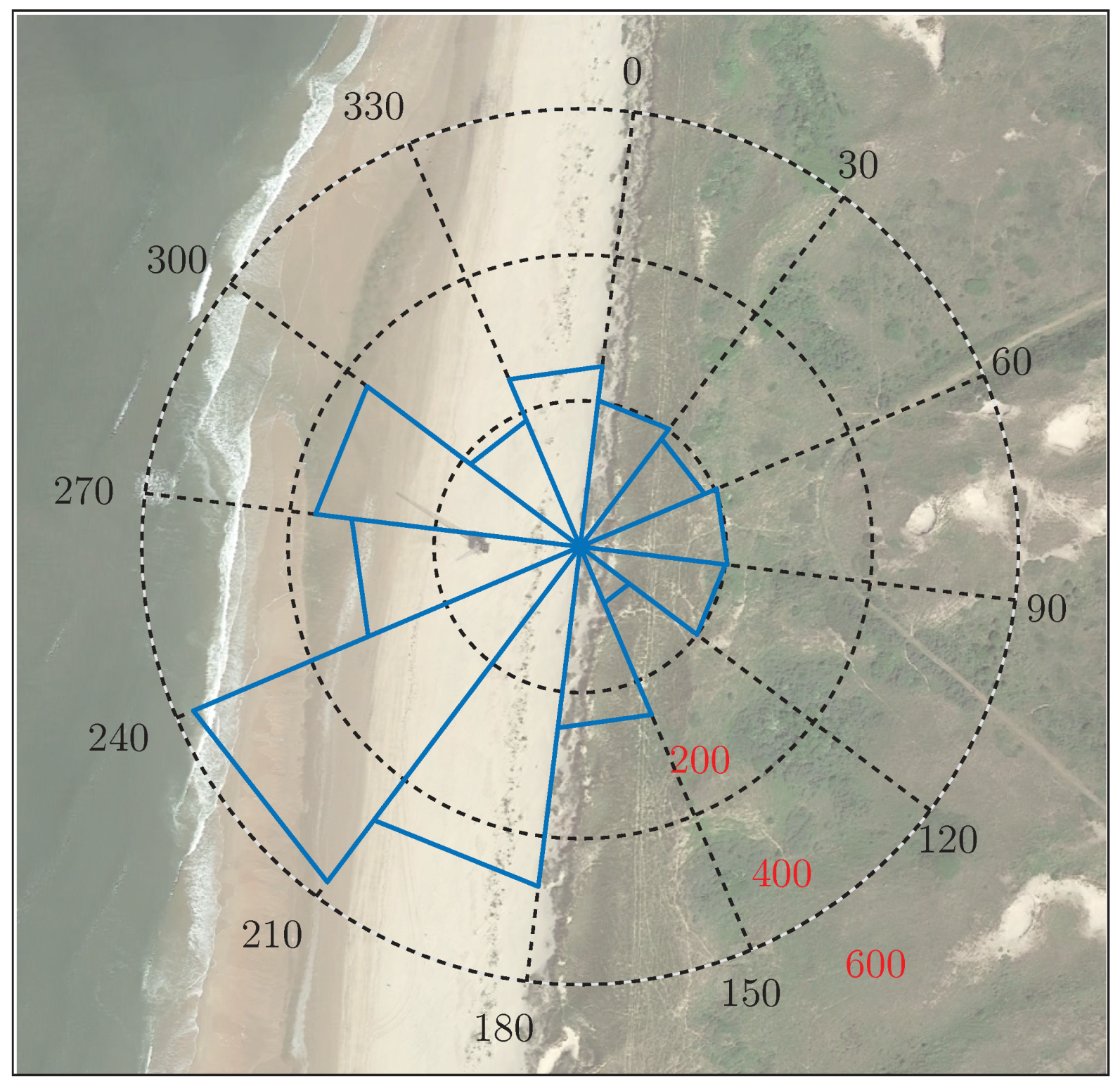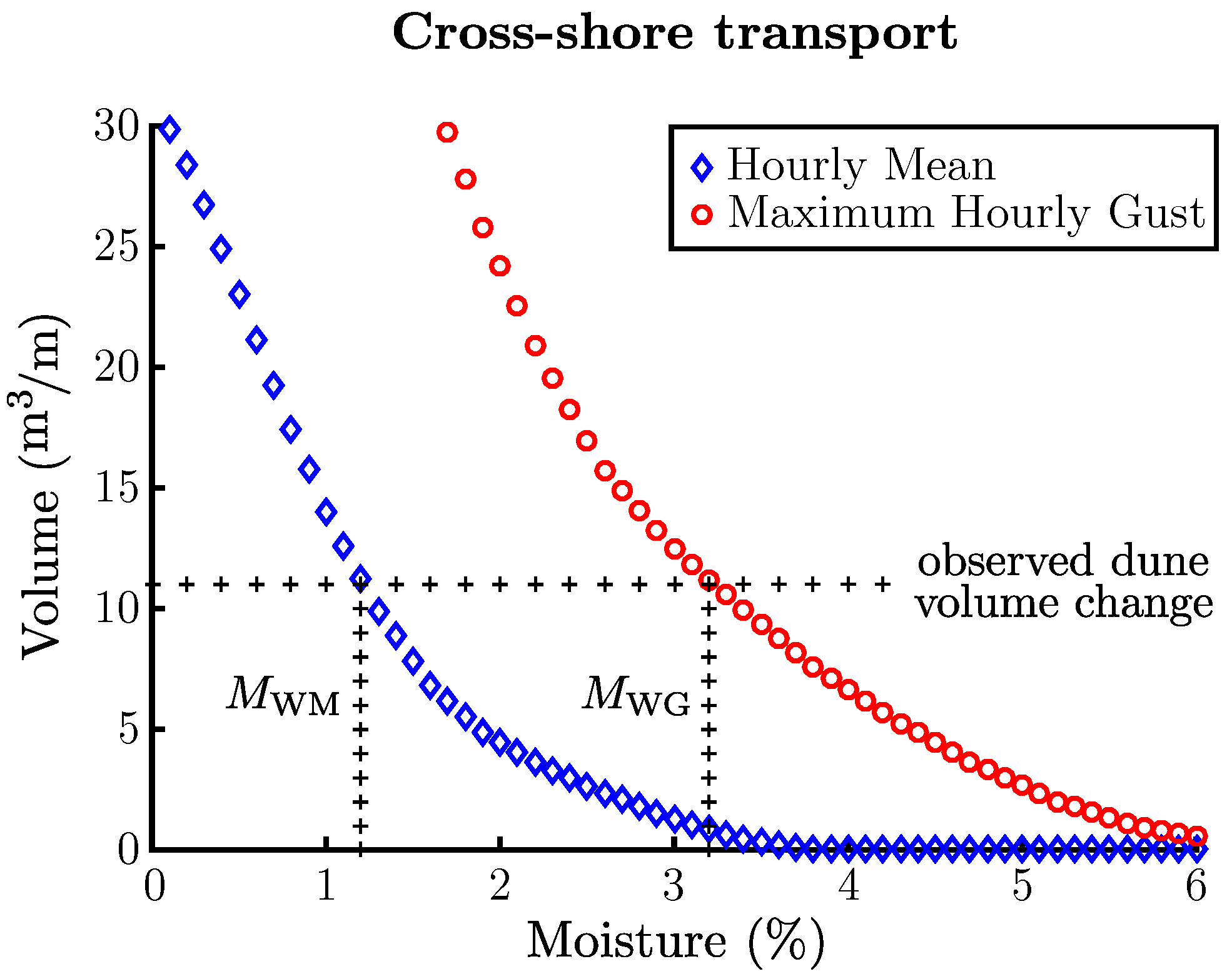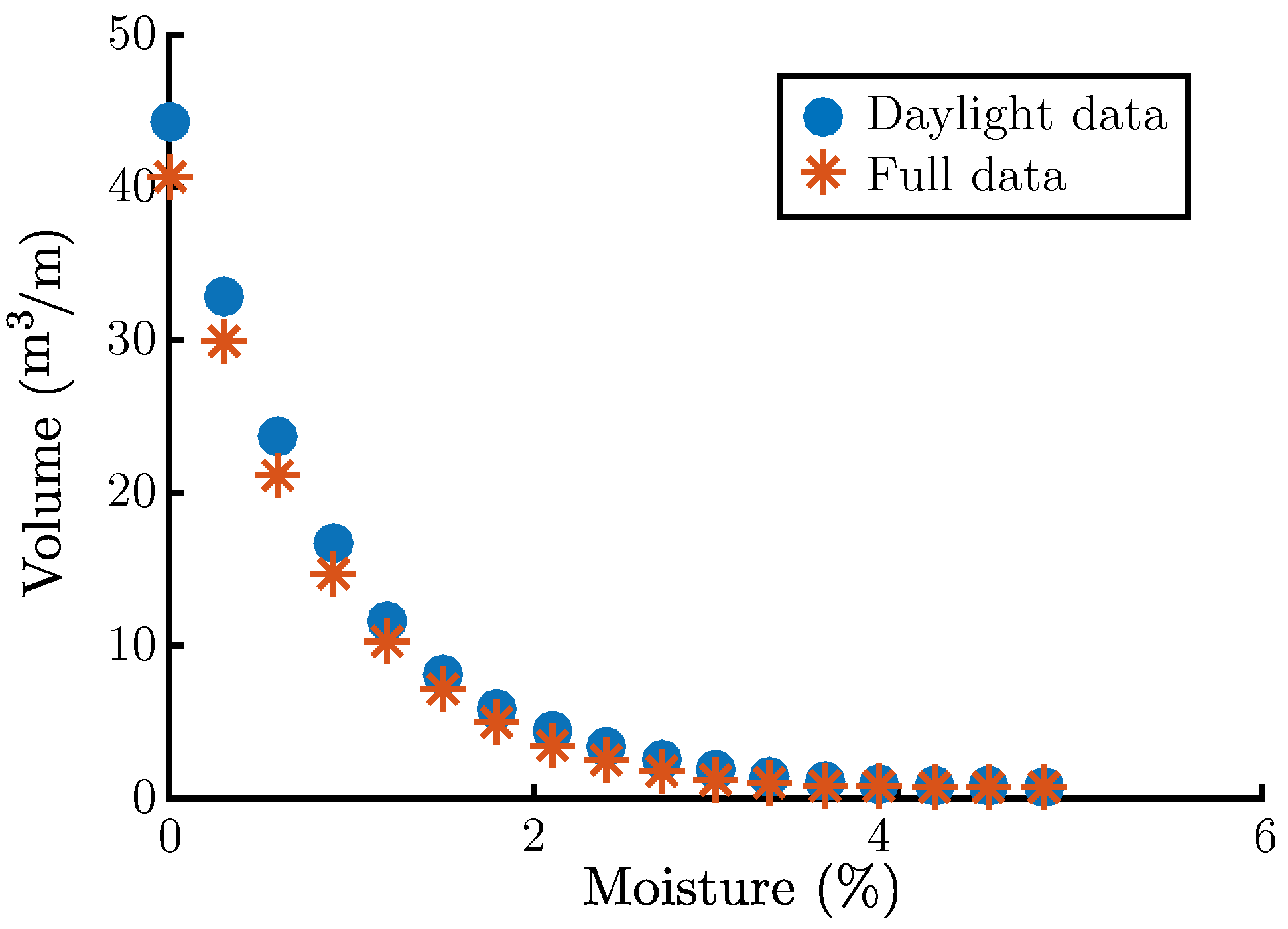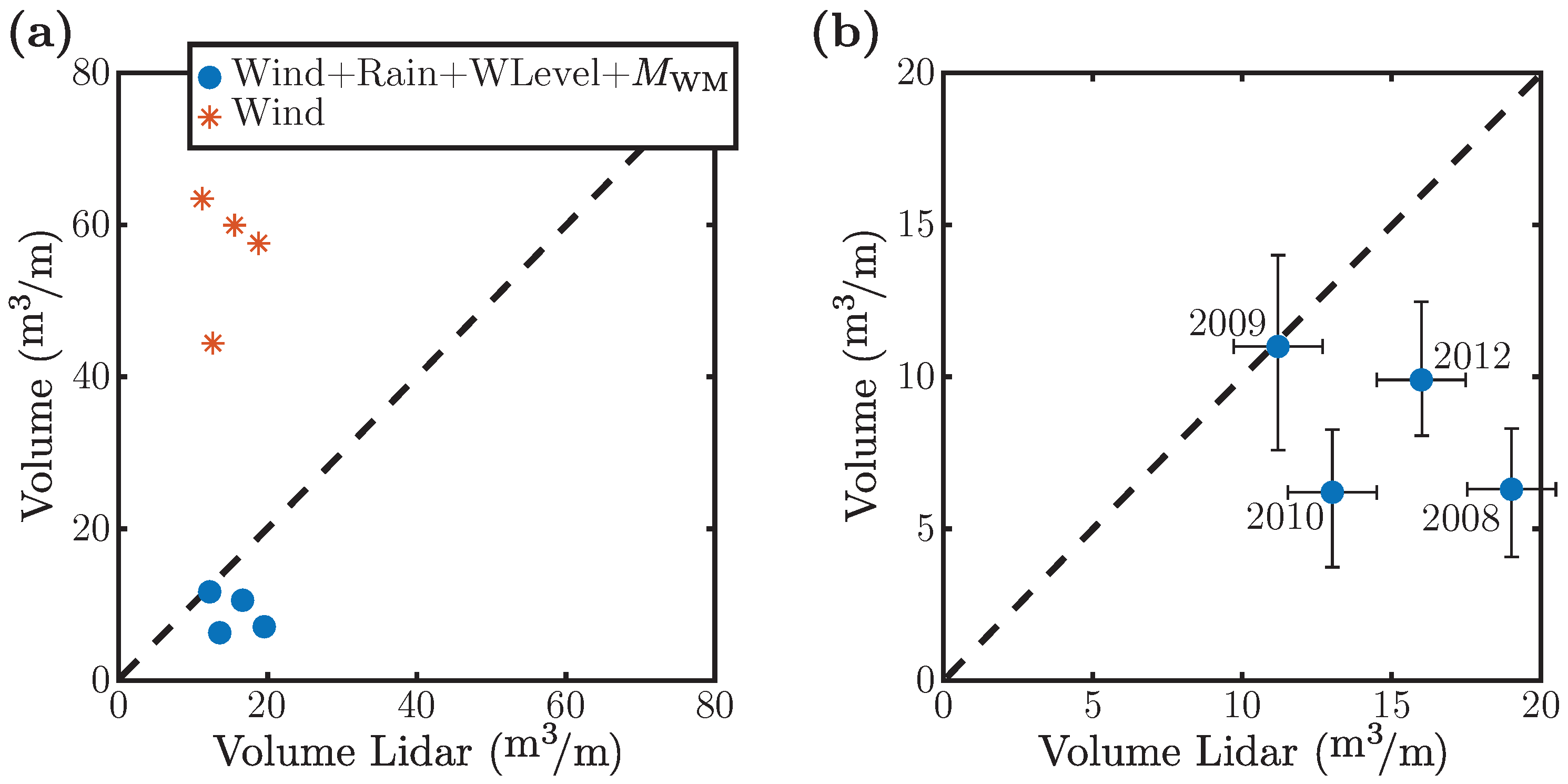Estimating Annual Onshore Aeolian Sand Supply from the Intertidal Beach Using an Aggregated-Scale Transport Formula
Abstract
:1. Introduction
2. Methods
2.1. Process-Based Formula to Quantify the Aeolian Sand Transport
2.2. Aggregated-Scale Transport Formula
2.3. Case Study Area
2.4. Argus Video Data
2.5. Airborne Laser Scanner (LiDAR)
2.6. Image Analysis Procedure
2.7. Meteorological Data
3. Results
3.1. Obtaining Aggregated-Scale Moisture Content
3.2. Assessing the Aggregated-Scale Transport Formula with the Characteristic Moisture Value
4. Discussion
5. Conclusions
- The approach described to determine a characteristic surface moisture content value for aeolian transport from the intertidal beach performs well and can be considered as a first step to obtain the long-term (annual-scale) quantification of aeolian sand transport towards the dunes, using aggregated scale, but a process-based formula and wind data.
- The representative moisture content values obtained (1.2% if hourly mean wind speed is used and 3.2% if hourly wind gust is used as input) imply that we need a quite dry beach surface indicating that the main source area for aeolian transport corresponds to the upper part of the intertidal beach, most likely the region between MHTL and SHTL.
- Due to the high dependency of the representative surface moisture content value on observed dune volume change, the accuracy of the topographic surveys is key to obtain a reliable and representative moisture content.
- The quantification needs the support of the images to detect the days or hours in which transport occurs. Therefore, the availability of video images is an important tool to corroborate the aeolian activity or transport at the beach.
Author Contributions
Funding
Acknowledgments
Conflicts of Interest
References
- Cohn, N.; Ruggiero, P.; Vries, S.; Kaminsky, G.M. New Insights on Coastal Foredune Growth: The Relative Contributions of Marine and Aeolian Processes. Geophys. Res. Lett. 2018, 45, 4965–4973. [Google Scholar] [CrossRef]
- Roelvink, D.; Reniers, A.; van Dongeren, A.; van Thiel de Vries, J.; McCall, R.; Lescinski, J. Modelling storm impacts on beaches, dunes and barrier islands. Coast. Eng. 2009, 56, 1133–1152. [Google Scholar] [CrossRef]
- Davidson-Arnott, R.; Bauer, B. Aeolian sediment transport on a beach: Thresholds, intermittency, and high frequency variability. Geomorphology 2009, 105, 117–126. [Google Scholar] [CrossRef]
- Hanson, H.; Larson, M.; Kraus, N.C. Calculation of beach change under interacting cross-shore and longshore processes. Coast. Eng. 2010, 57, 610–619. [Google Scholar] [CrossRef]
- Delgado-Fernandez, I.; Davidson-Arnott, R.; Ollerhead, J. Application of a Remote Sensing Technique to the Study of Coastal Dunes. J. Coast. Res. 2009, 25, 1160–1167. [Google Scholar] [CrossRef]
- Delgado-Fernandez, I.; Davidson-Arnott, R. Meso-scale aeolian sediment input to coastal dunes: The nature of aeolian transport events. Geomorphology 2011, 126, 217–232. [Google Scholar] [CrossRef] [Green Version]
- Sherman, D.J.; Jackson, D.W.T.; Namikas, S.L.; Wang, J. Wind-blown sand on beaches: An evaluation of models. Geomorphology 1998, 22, 113–133. [Google Scholar] [CrossRef]
- Sherman, D.J.; Li, B.; Ellis, J.T.; Farrell, E.J.; Maia, L.P.; Granja, H. Recalibrating aeolian sand transport models. Earth Surf. Proc. Landf. 2013, 38, 169–178. [Google Scholar] [CrossRef]
- Bagnold, R.A. The Physics of Blown Sand and Desert Dunes; Dover Publications, Inc.: Mineola, NY, USA, 1941; Second Edition 1954; Reprinted by Dover in 2004. [Google Scholar]
- Kawamura, R. Study of Sand Movement by Wind; Report HEL-2-8; Hydraulic Engineering Laboratory, University of California: Berkeley, CA, USA, 1951; Translated from Japanese, 1964. [Google Scholar]
- Owen, P.R. Saltation of uniform grains in air. J. Fluid Mech. 1964, 20, 225–242. [Google Scholar] [CrossRef]
- Lettau, K.; Lettau, H. Experimental and micrometeorological field studies of dune migration. In Exploring the World’s Driest Climate; Lettau, H.H., Lettau, K., Eds.; Center for Climatic Research, University Wisconsin-Madison: Madison, WI, USA, 1977; pp. 110–147. [Google Scholar]
- Durán, O.; Claudin, P.; Andreotti, B. On aeolian transport: Grain-scale interactions, dynamical mechanisms and scaling laws. Aeolian Res. 2011, 3, 243–270. [Google Scholar] [CrossRef]
- Kok, J.F.; Parteli, E.J.R.; Michaels, T.I.; Karam, D.B. The physics of wind-blown sand and dust. Rep. Prog. Phys. 2012, 75, 106901. [Google Scholar] [CrossRef] [PubMed]
- Hsu, S.A. Computing Eolian Sand Transport from Routine Weather Data. In Proceedings of the 14th Conference on Coastal Engineering, Copenhagen, Denmark, 24–28 July 1974; ASCE: New York, NY, USA, 1974; pp. 1619–1626. [Google Scholar]
- Sherman, D.J. An equilibrium relationship for shear velocity and roughness length in aeolian saltation. Geomorphology 1992, 5, 419–431. [Google Scholar] [CrossRef]
- Bauer, B.; Davidson-Arnott, R.; Hesp, P.; Namikas, S.; Ollerhead, J.; Walker, I. Aeolian sediment transport on a beach: Surface moisture, wind fetch, and mean transport. Geomorphology 2009, 105, 106–116. [Google Scholar] [CrossRef]
- Delgado-Fernandez, I.; Davidson-Arnott, R.; Bauer, B.O.; Walker, I.J.; Ollerhead, J.; Rhew, H. Assessing aeolian beach-surface dynamics using a remote sensing approach. Earth Surf. Proc. Landf. 2012, 37, 1651–1660. [Google Scholar] [CrossRef] [Green Version]
- Nield, J.M. Surface moisture-induced feedback in aeolian environments. Geology 2011, 39, 915–918. [Google Scholar] [CrossRef]
- Smit, Y.; Ruessink, B.G.; Brakenhoff, L.B.; Donker, J.J. Measuring spatial and temporal variation in surface moisture on a coastal beach with a near-infrared terrestrial laser scanner. Aeolian Res. 2018, 31, 19–27. [Google Scholar] [CrossRef]
- Udo, K.; Kuriyama, Y.; Jackson, D.W.T. Observations of wind-blown sand under various meteorological conditions at a beach. J. Geophys. Res. Earth Surf. 2008, 113, F04008. [Google Scholar] [CrossRef]
- Hotta, S.; Kubota, S.; Katori, S.; Horikawa, K. Sand Transport by Wind on a Wet Sand Surface. In Proceedings of the 19th Conference on Coastal Engineering, Houston, TX, USA, 3–7 Septembre 1984; ASCE: New York, NY, USA, 1984; pp. 1265–1281. [Google Scholar]
- Belly, P.Y. Sand Movement by Wind; CERC Tech. Mem. 1, Addendum III; U.S. Army Corps of Engineers: Washington, DC, USA, 1964; 24p. [Google Scholar]
- Dong, Z.; Liu, X.; Wang, X. Wind initiation thresholds of the moistened sands. Geophys. Res. Lett. 2002, 29, 25-1–25-4. [Google Scholar] [CrossRef]
- Bauer, B.O.; Davidson-Arnott, R.G.D. A general framework for modeling sediment supply to coastal dunes including wind angle, beach geometry, and fetch effects. Geomorphology 2003, 49, 89–108. [Google Scholar] [CrossRef]
- Holman, R.; Stanley, J. The history and technical capabilities of Argus. Coast. Eng. 2007, 54, 477–491. [Google Scholar] [CrossRef]
- Smit, M.; Aarninkhof, S.; Wijnberg, K.; Gonzalez, M.; Kingston, K.; Southgate, H.; Ruessink, B.; Holman, R.; Siegle, E.; Davidson, M.; Medina, R. The role of video imagery in predicting daily to monthly coastal evolution. Coast. Eng. 2007, 54, 539–553. [Google Scholar] [CrossRef]
- Quartel, S.; Kroon, A.; Ruessink, B. Seasonal accretion and erosion patterns of a microtidal sandy beach. Mar. Geol. 2008, 250, 19–33. [Google Scholar] [CrossRef]
- Revollo, N.V.; Delrieux, C.A.; Perillo, G.M. Automatic methodology for mapping of coastal zones in video sequences. Mar. Geol. 2016, 381, 87–101. [Google Scholar] [CrossRef]
- Van der Weerd, A.J.; Wijnberg, K.M. Aeolian Sediment Flux Derived from a Natural Sand Trap. J. Coast. Res. 2016, 75, 338–342. [Google Scholar] [CrossRef] [Green Version]
- Hage, P.; Ruessink, B.; Donker, J. Determining sand strip characteristics using Argus video monitoring. Aeolian Res. 2018, 33, 1–11. [Google Scholar] [CrossRef]
- Williams, I.A.; Wijnberg, K.M.; Hulscher, S.J.M.H. Detection of aeolian transport in coastal images. Aeolian Res. 2018, 35, 47–57. [Google Scholar] [CrossRef]
- Van Rijn, L.; Walstra, D.; Grasmeijer, B.; Sutherland, J.; Pan, S.; Sierra, J. The predictability of cross-shore bed evolution of sandy beaches at the time scale of storms and seasons using process-based Profile models. Coast. Eng. 2003, 47, 295–327. [Google Scholar] [CrossRef]
- Bakker, M.A.J.; van Heteren, S.; Vonhögen, L.M.; van der Spek, A.J.F.; van der Valk, B. Recent Coastal Dune Development: Effects of Sand Nourishments. J. Coast. Res. 2012, 28, 587–601. [Google Scholar] [CrossRef]
- De Winter, R.; Gongriep, F.; Ruessink, B. Observations and modeling of alongshore variability in dune erosion at Egmond aan Zee, the Netherlands. Coast. Eng. 2015, 99, 167–175. [Google Scholar] [CrossRef]
- Uunk, L.; Wijnberg, K.; Morelissen, R. Automated mapping of the intertidal beach bathymetry from video images. Coast. Eng. 2010, 57, 461–469. [Google Scholar] [CrossRef]
- De Winter, W.; van Dam, D.; Delbecque, N.; Verdoodt, A.; Ruessink, B.; Sterk, G. Measuring high spatiotemporal variability in saltation intensity using a low-cost Saltation Detection System: Wind tunnel and field experiments. Aeolian Res. 2018, 31, 72–81. [Google Scholar] [CrossRef]
- Lynch, K.; Jackson, D.W.T.; Cooper, J.A.G. The fetch effect on aeolian sediment transport on a sandy beach: A case study from Magilligan Strand, Northern Ireland. Earth Surf. Proc. Landf. 2016, 41, 1129–1135. [Google Scholar] [CrossRef]
- Bochev-van der Burgh, L.M.; Wijnberg, K.M.; Hulscher, S.J.M.H. Decadal-scale morphologic variability of managed coastal dunes. Coast. Eng. 2011, 58, 927–936. [Google Scholar] [CrossRef]
- Ruessink, B.; Arens, S.; Kuipers, M.; Donker, J. Coastal dune dynamics in response to excavated foredune notches. Aeolian Res. 2018, 31, 3–17. [Google Scholar] [CrossRef]
- Rijkswaterstaat. Kwaliteitsdocument laseraltimetrie. Deel 2: Projectgebied Kust 2012 Perceel 1; Data-ICT Dienst: Utrecht, The Netherlands, 2012. (In Dutch) [Google Scholar]
- Bauer, B.O.; Hesp, P.A.; Walker, I.J.; Davidson-Arnott, R.G. Sediment transport (dis)continuity across a beach-dune profile ing an offshore wind event. Geomorphology 2015, 245, 135–148. [Google Scholar] [CrossRef]
- Nordstrom, K.F.; Jackson, N.L. Offshore aeolian sediment transport across a human-modified foredune. Earth Surf. Proc. Landf. 2017, 43, 195–201. [Google Scholar] [CrossRef] [Green Version]
- Reim, E. Annual Aeolian Sediment Transport from the Intertidal Beach. Master’s Thesis, University of Twente, Enschede, The Netherlands, 2013. [Google Scholar]
- Kim, S.W.; Yun, K.; Yi, K.M.; Kim, S.J.; Choi, J.Y. Detection of Moving Objects with a Moving Camera Using Non-panoramic Background Model. Mach. Vis. Appl. 2013, 24, 1015–1028. [Google Scholar] [CrossRef]
- Bagnold, R.A. The Movement of Desert Sand. Proc. R. Soc. A 1936, 157, 594–620. [Google Scholar] [CrossRef]
- Bauer, B.O.; Davidson-Arnott, R.G.D.; Walker, I.J.; Hesp, P.A.; Ollerhead, J. Wind direction and complex sediment transport response across a beach-dune system. Earth Surf. Proc. Landf. 2012, 37, 1661–1677. [Google Scholar] [CrossRef]
- Azizov, A. Influence of soil moisture on the resistance of soil to wind erosion. Sov. Soil Sci. 1977, 9, 105–108. [Google Scholar]
- Davidson-Arnott, R.G.D.; Bauer, B.O.; Walker, I.J.; Hesp, P.A.; Ollerhead, J.; Delgado-Fernandez, I. Instantaneous and mean aeolian sediment transport rate on beaches: an intercomparison of measurements from two sensor types. J. Coast. Res. 2009, 56, 297–301. [Google Scholar]
- Davidson-Arnott, R.G.D.; Yang, Y.; Ollerhead, J.; Hesp, P.A.; Walker, I.J. The effects of surface moisture on aeolian sediment transport threshold and mass flux on a beach. Earth Surf. Proc. Landf. 2008, 33, 55–74. [Google Scholar] [CrossRef]
- Stive, M.J.; de Schipper, M.A.; Luijendijk, A.P.; Aarninkhof, S.G.; van Gelder-Maas, C.; van Thiel de Vries, J.S.; de Vries, S.; Henriquez, M.; Marx, S.; Ranasinghe, R. A New Alternative to Saving Our Beaches from Sea-Level Rise: The Sand Engine. J. Coast. Res. 2013, 29, 1001–1008. [Google Scholar] [CrossRef]
- Silva, F.G.; Wijnberg, K.M.; de Groot, A.V.; Hulscher, S.J.M.H. The influence of groundwater depth on coastal dune development at sand flats close to inlets. Ocean Dyn. 2018, 68, 885–897. [Google Scholar] [CrossRef]
- Montreuil, A.L.; Chen, M.; Brand, E.; Strypsteen, G.; Rauwoens, P.; Vandenbulcke, A.; De Wulf, A.; Dan, S.; Verwaest, T. Dynamics of Surface Moisture Content on a Macro-tidal Beach. J. Coast. Res. 2018, 85, 206–210. [Google Scholar] [CrossRef]
- Namikas, S.; Edwards, B.; Bitton, M.; Booth, J.; Zhu, Y. Temporal and spatial variabilities in the surface moisture content of a fine-grained beach. Geomorphology 2010, 114, 303–310. [Google Scholar] [CrossRef]
- Poortinga, A.; van Rheenen, H.; Ellis, J.T.; Sherman, D.J. Measuring aeolian sand transport using acoustic sensors. Aeolian Res. 2015, 16, 143–151. [Google Scholar] [CrossRef]
- Rijkswaterstaat. Kwaliteitsdocument Laseraltimetrie: Resultaten Controles Kust; Combinatie Hansa Luftbild/ TopScan in Opdracht van Rijkswaterstaat: Utrecht, The Netherlands, 2015. (In Dutch) [Google Scholar]
- Jensen, S.G.; Aagaard, T.; Baldock, T.E.; Kroon, A.; Hughes, M. Berm formation and dynamics on a gently sloping beach; the effect of water level and swash overtopping. Earth Surf. Proc. Landf. 2009, 34, 1533–1546. [Google Scholar] [CrossRef]
- Aarninkhof, S.G.; Turner, I.L.; Dronkers, T.D.; Caljouw, M.; Nipius, L. A video-based technique for mapping intertidal beach bathymetry. Coast. Eng. 2003, 49, 275–289. [Google Scholar] [CrossRef]
















| Grain Size (μm) | C |
|---|---|
| 45–54 | 1.59 |
| 54–77 | 1.85 |
| 77–90 | 2.46 |
| 90–100 | 1.66 |
| 100–135 | 2.51 |
| 135–150 | 2.05 |
| 150–200 | 2.75 |
| 200–250 | 1.59 |
| 250–400 | 1.87 |
| 400–500 | 2.15 |
| Rain | |||
|---|---|---|---|
| Yes | No | ||
| Transport Images | Yes | 113 | 615 |
| No | 224 | 1456 | |
| Year | Lidar Survey Dates | Max Water Level |
|---|---|---|
| 2008 | 9 April 2008–18 March 2009 | 1.85 m |
| 2009 | 18 March 2009–11 March 2010 | 1.92 m |
| 2010 | 11 March 2010–27 January 2011 | 1.79 m |
| 2012 | 1 February 2012–14 January 2013 | 1.71 m |
| Year | + | + | + + | () | ||
|---|---|---|---|---|---|---|
| 2008 | 18.8 | 14.2 | 6.3 | 13.4 | 6.3 | 57.6 |
| 2009 | 11.2 | 18.0 | 11.1 | 17.8 | 11.0 | 63.4 |
| 2010 | 12.6 | 11.5 | 8.0 | 9.6 | 6.2 | 44.4 |
| 2012 | 15.6 | 15.1 | 9.9 | 15.1 | 9.9 | 60.0 |
| Year | + | + | + + | (0%) | ||
|---|---|---|---|---|---|---|
| 2008 | 18.8 | 14.7 | 4.7 | 12.8 | 4.7 | 131.1 |
| 2009 | 11.2 | 18.8 | 10.0 | 18.8 | 9.9 | 146.9 |
| 2010 | 12.6 | 8.6 | 5.2 | 6.2 | 2.8 | 103.6 |
| 2012 | 15.6 | 19.3 | 11.4 | 19.3 | 11.4 | 149.6 |
| Rain | |||
|---|---|---|---|
| Yes | No | ||
| Transport Images | Yes | 84 | 422 |
| No | 93 | 524 | |
| Rain | |||
|---|---|---|---|
| Yes | No | ||
| Transport Images | Yes | 0.07 | 0.17 |
| No | 0.26 | 0.24 | |
| Year | + | + | + + | ||
|---|---|---|---|---|---|
| 2008 | 15.8 | 18.0 | 10.1 | 17.1 | 10.1 |
| 2009 | 14.2 | 22.7 | 15.7 | 22.4 | 15.5 |
| 2010 | 9.6 | 14.8 | 11.3 | 12.8 | 9.4 |
| 2012 | 12.6–18.6 | 19.0 | 14.1 | 19.0 | 14.1 |
© 2018 by the authors. Licensee MDPI, Basel, Switzerland. This article is an open access article distributed under the terms and conditions of the Creative Commons Attribution (CC BY) license (http://creativecommons.org/licenses/by/4.0/).
Share and Cite
Duarte-Campos, L.; Wijnberg, K.M.; Hulscher, S.J.M.H. Estimating Annual Onshore Aeolian Sand Supply from the Intertidal Beach Using an Aggregated-Scale Transport Formula. J. Mar. Sci. Eng. 2018, 6, 127. https://doi.org/10.3390/jmse6040127
Duarte-Campos L, Wijnberg KM, Hulscher SJMH. Estimating Annual Onshore Aeolian Sand Supply from the Intertidal Beach Using an Aggregated-Scale Transport Formula. Journal of Marine Science and Engineering. 2018; 6(4):127. https://doi.org/10.3390/jmse6040127
Chicago/Turabian StyleDuarte-Campos, Leonardo, Kathelijne M. Wijnberg, and Suzanne J. M. H. Hulscher. 2018. "Estimating Annual Onshore Aeolian Sand Supply from the Intertidal Beach Using an Aggregated-Scale Transport Formula" Journal of Marine Science and Engineering 6, no. 4: 127. https://doi.org/10.3390/jmse6040127





